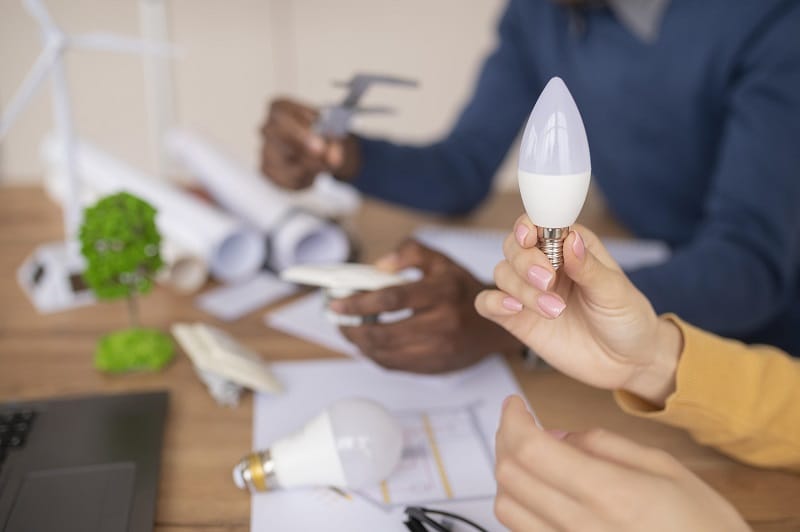
There are numerous approaches to energy management depending on your organization, resources, and goals. Choosing the smartest method can be challenging. These business executives share their strategies for energy management in their respective fields below.
Analyzing energy usage patterns and identifying areas of waste
Energy management is a complex and critical task that every individual and organization must handle effectively to reduce energy consumption and costs. The smartest approach to energy management involves a careful analysis of energy usage patterns, identifying areas of waste, and implementing energy-saving practices and technologies. This approach relies on a combination of technical expertise and personal responsibility in making small changes that add up to significant savings over time.
Effective energy management is not just about cutting costs but also promoting sustainability and reducing carbon footprints. By adopting a smart approach to energy management, we can all play an active role in conserving our planet’s resources and reducing our environmental impact.
Employ a combination of strategies
The smarter approach to energy management is to use a combination of strategies. First, it is essential to use energy-efficient technologies and practices. This may include installing LED lighting, using high-efficiency appliances and HVAC systems, and utilizing renewable energy sources. Second, it is important to monitor energy consumption in order to identify areas for improvement. Using tools such as energy audits or smart meters can help businesses better understand their usage patterns and find opportunities for savings.
Finally, businesses should strive to reduce their energy consumption in order to save money and support environmental sustainability. Examples of practices include switching off equipment when not in use, using timers and motion sensors to control lighting, improving insulation and air sealing, and scheduling regular maintenance checks. Adopting these strategies can help businesses effectively manage their energy usage and save money in the long term.
Assess your current usage and set realistic goals
The smarter approach to energy management is to start by assessing your current usage. This can be done through an audit of your building or a comprehensive analysis of all the inputs and outputs in order to establish where you are currently using energy most inefficiently. Once this baseline data has been gathered, it is important to set realistic goals and develop a strategy to achieve them. This may include implementing energy-saving measures such as updating lighting systems, investing in more efficient appliances, and upgrading insulation.
Additionally, it may be beneficial to establish monitoring systems that allow you to constantly track and adjust your energy usage in order to maximize efficiency. It is also important to consider alternative sources of energy, such as solar and wind power, as these have the potential to lower your utility costs significantly.
Focus on efficiency and conservation
The smarter approach that I can share about energy management is to focus on efficiency and conservation. Efficiency means using the least amount of energy to [achieve] a desired result, while conservation refers to reducing or limiting the use of energy.
By implementing efficient technologies and practices, such as LED lighting, smart thermostats, efficient appliances, building insulation, and proper maintenance schedules, businesses and consumers alike can reduce their energy consumption significantly. Furthermore, activities like setting realistic goals for electricity usage and creating an action plan are important steps in successfully managing energy.
When it comes to procuring energy, businesses can benefit from renewable sources such as solar or wind-generated electricity. Such clean sources of power not only reduce the need for more traditional types of energy like coal or oil-based products but also help organizations lower their carbon footprints – something that is becoming increasingly important to many companies in today’s market. Additionally, taking advantage of certain government incentives can further reduce costs associated with switching to renewables.
Ultimately, the goal should be to create a comprehensive system for long-term sustainability where the continual development of new green technology, along with appropriate educational efforts, are used in concert with existing initiatives to encourage increased environmental awareness among both business owners and consumers alike.
Adopt energy-efficient equipment and an energy-conscious culture
Managing energy well is a key part of living in a healthy way. It means knowing and keeping track of how energy is used, putting in place energy-efficient technologies, and using smart practices to cut down on waste. By putting energy management at the top of their list of priorities, people can reduce their carbon footprint, lower their power bills, and help make the world a greener place for future generations. It’s the right thing to do, and it helps both the earth and your own finances.
Smarter approach in energy management
1. Prioritize adoption of energy-efficient technologies and equipment:
Adopting energy-efficient technologies and equipment is another wise strategy. Appliances, lights, HVAC, and insulation solutions that are energy-efficient are made to operate using less energy. These energy-saving measures can help you save a lot of energy over the long run.
When choosing new equipment, it’s critical to take energy efficiency ratings into account, such as ENERGY STAR certification. Incorporating renewable energy resources, such as solar or wind energy, can also help to promote sustainability by reducing reliance on conventional energy grids.
2. Encourage family engagement and an energy-conscious culture:
A wise strategy for energy management is to develop an energy-conscious culture inside a firm. Businesses can harness the power of group action by spreading awareness and involving staff in energy-saving activities. Energy usage can be significantly reduced by encouraging staff to adopt energy-saving behaviors, including turning off lights when not in use, utilizing energy-efficient modes on electronics, and adjusting heating and cooling systems.
Employee participation in energy-saving techniques can be further encouraged by regular communication, training opportunities, and rewards. Organizations can achieve long-term sustainability goals and promote continual improvement in energy management by establishing a culture of energy conservation.
Utilize smart building technologies
One of the smarter approaches that I can share is to utilize smart building technologies. These technologies incorporate advanced features such as automated lighting systems, occupancy sensors, and programmable thermostats, which can significantly reduce your energy consumption. By implementing these technologies, you can effectively optimize your energy usage and curb unnecessary energy wastage.
Automated lighting systems and occupancy sensors can help in reducing electricity usage by only turning on lights when they are required and turning them off when they are not in use, resulting in significant energy savings. Similarly, programmable thermostats can help maintain optimal indoor temperatures by adjusting the temperature settings based on occupancy patterns, which can further contribute to energy conservation.
Therefore, by adopting smart building technologies such as lighting systems, occupancy sensors, and programmable thermostats, you can take a smarter approach to energy management and make significant strides in reducing your energy consumption.
Embrace energy storage solutions and use management software
Energy management is the art of controlling and saving energy sources in a planned way. It includes things like keeping track of how much energy is used, making sure energy efficiency is at its best, and using green energy sources. By managing energy well, people and businesses can not only save money but also help make the world a more sustainable and environmentally friendly place by reducing their carbon output and reliance on nonrenewable energy.
Embrace energy storage solutions:
An intelligent strategy for energy management involves integrating energy storage options like thermal or battery systems. These systems make it possible to store and utilize extra energy produced during off-peak hours or from renewable sources.
People and organizations can minimize their dependency on the grid during peak hours and optimize their energy use by efficiently storing and using energy. Additionally, [by] supplying backup power during grid failures, energy storage improves resilience and dependability.
Use modern energy management software:
Making use of modern energy management software is another wise move. Real-time monitoring, analytics, and control capabilities for energy usage across diverse systems and devices are provided by these software solutions. These software platforms offer insights into energy consumption trends, spot anomalies, and make suggestions for maximizing energy use by integrating data from sensors, smart meters, and other sources.
Users can use them to track performance over time, automate energy-saving actions, and make informed decisions. Advanced energy management software enables people and businesses to save money and use less energy by leveraging the power of data and analytics.
This is a crowdsourced article. Contributors’ statements do not necessarily reflect the opinion of this website, other people, businesses, or other contributors.
.contribution { width: 100%; clear: both; display: block; padding: 30px 0px 30px 0px; position: relative;
height: auto; overflow: hidden; }
.contribution img {display: block; margin-bottom: 10px !important; margin-left: auto; margin-top:15px !important;
margin-right: auto;}
.contribution-headshot { max-width: 200px; }
.contribution-text { max-width: 800px; text-align: left; }
.contribution-left { float: left; margin-right:20px;}
.contribution-right { float: right; }
.contribution-divider { border-top: 2px solid #666; margin: 30px 0px 30px 0px; clear: both; }
.contributor-name {font-size:16px;text-align:center;
margin-bottom:0px !important;
}
.contributor-bio {font-size:13px !important;text-align:center; line-height:1.4em;}
.contribution-left2 { float: left; }
.contribution-right2 { float: right;}
.contribution-text2 { max-width: 800px; text-align: left; }
@media all and (min-width:981px){
.contribution-left { width:25%;}
.contribution-right2 { width:25%;}
.contribution-left2 { width:70%;}
.contribution-right { width:70%;}
}
@media all and (max-width:980px){
.contribution-left, .contribution-right2{margin-bottom:30px !important; width:100% !important;}
.contribution-left2, .contribution-right{width:100% !important;}
}
.contributor-position{text-align:center; font-size:13px !important;}
.contribution-text ol,ul{
font-size: 15px;
color: #000000;
line-height: 21px;padding-bottom:15px !important;}
.contribution-text2 ol,ul{
font-size: 15px;
color: #000000;
line-height: 21px;padding-bottom:15px !important;}
.disclosures { font-size: 11px; font-style: italic; text-align: center; background: #efefef; padding: 15px !important; margin: 50px 0px 20px 0px; clear: both; line-height:1.4em; }
.contributor-job, .contributor-company, .work-info{text-align:center; line-height:1.4em;}
Others articles you might like
A guide to understanding how net metering saves you money
When net metering was first introduced in Idaho and Arizona back in the 1980s, it was a game-changer in the renewable energy landscape. The ...
25 July 2024Five energy procurement strategies for businesses
Securing the right energy contract isn't just about locking in the best rates. Energy procurement includes safeguarding your bottom line,...
9 April 2024Stabilizing energy costs in a volatile market
When we flip a switch, indoor lighting comes on with nearly the same dependability as the sun rising. This makes sense; the outside world...
21 March 2024










